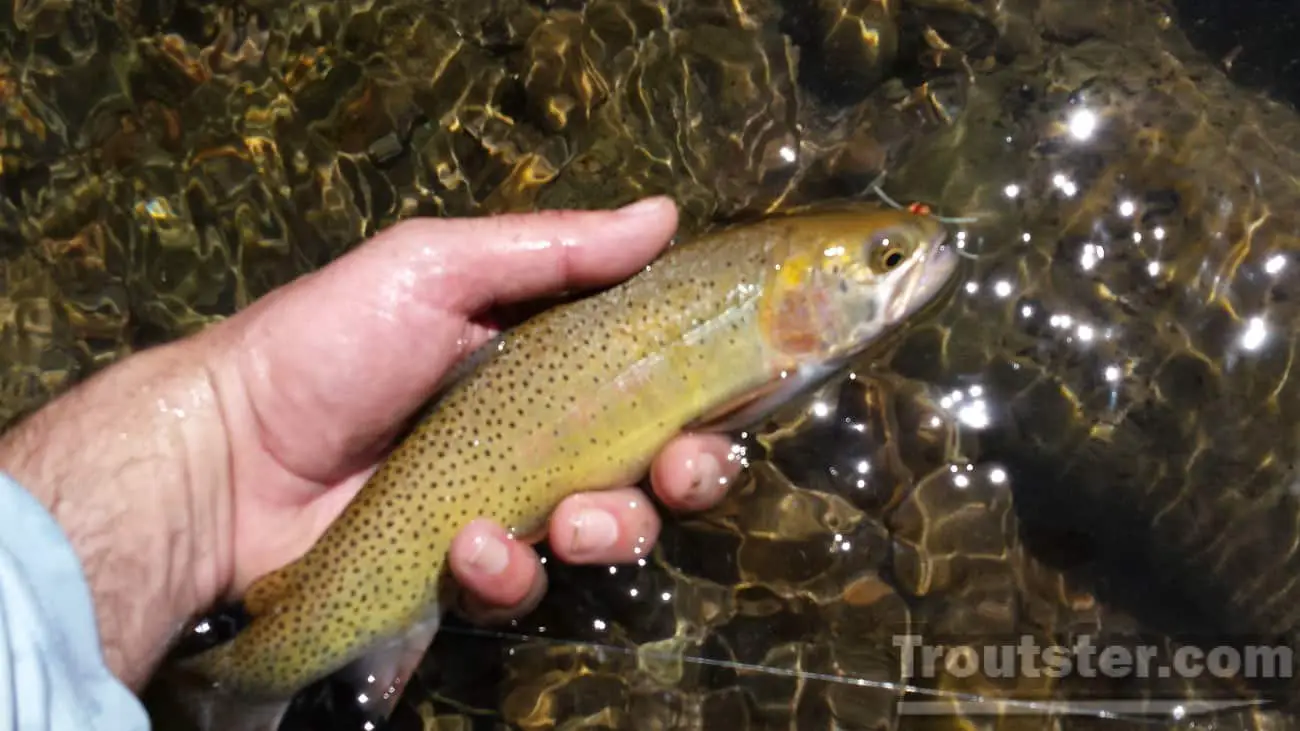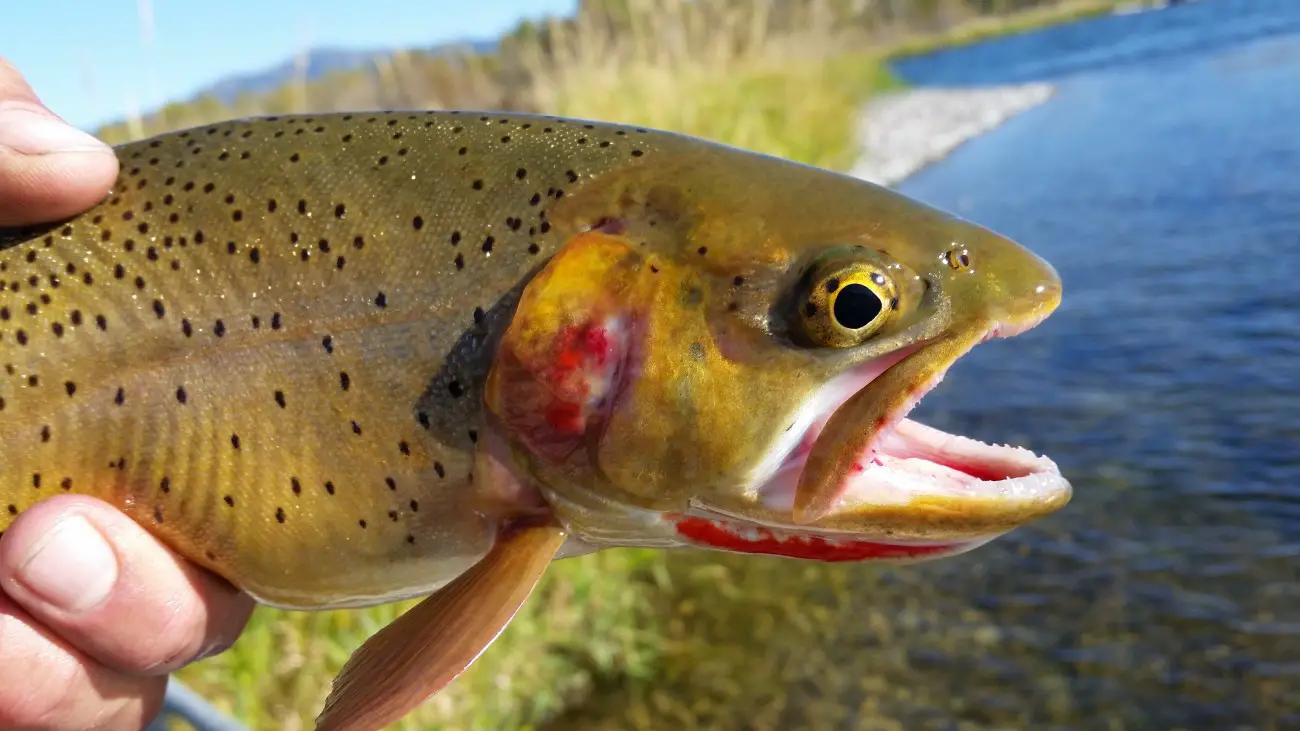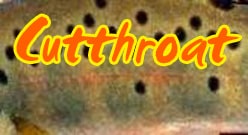This post was last updated on June 30th, 2021 at 06:34 pm

About the Cutthroat Trout
The Cutthroat trout evolved into its current form in the Western United States in a rugged mountainous terrain. This terrain kept individual “pods” of cutthroats in isolated areas, and their gene pools limited from encounters with various other trout during their evolution. This led to many different separately evolved sub species of the cutthroat. Divided by large mountains and drainage’s, each sub species took on their own coloration, habits and traits. These fractured pockets led to some pretty major differences in many of these sub species. Aside from the obvious spots and slight differences in color, the cutthroats all evolved their own particular habits. Many of the cutthroat trout sub species tend to even prey on particular food sources such as other fish and totally disregard most insects as a food source. You can also see some huge differences in the overall sizes of these fish. For instance the Rio Grande Cutthroat will grow to a maximum size of 12-13 inches, while the Lahontan strain has a world record fish that is over 40 lbs and they are common over 30 inches in length.

Cutthroat Trout Identification
The cutthroat can be identified by its typical orange marks along the undersides of their mandibles at the lower folding of the gill plate area. These “cuts” are what give this trout it’s name. The coloration between the various subspecies can differ quite drastically, however most can easily be distinguished from other trout species such as the brook or brown, by the type of spots and yellow and reddish coloration of the fish overall.
Threats To the Cutthroat Trout
The extreme fine tuned traits of all of these sub species of cutthroat has lead to a very fragile species overall. With little competition from other trout throughout their evolution, they are now left vulnerable to a lot of different threats. When man came from Europe, with him came the desire to plant other species of trout. These other species such as the lake trout, brown trout and brook trout have had severe impacts on the cutthroat species. In many cases these “foreign” trout effect the cutthroat in many different ways.
How Have Non-Native Trout Affected the Cutthroat Trout Population?
- Through competition for food sources
- Competition for breeding and spawning habitat
- Heavy predation on the cutthroat directly
- Severe interbreeding with the cutthroats, causing a diluted gene pool or “hybridization” especially by the rainbow trout
Negative Impact of Man on the Cutthroat Trout
- Heavy logging: around the rivers causing increasing stream temperatures and extreme amounts of sawdust
- Mining: in areas have had major effects directly and indirectly. In many cases species of cutthroat were nearly eliminated just to feed the loggers and miners in certain areas.
- Pollution: with chemicals from plants and factories
- Irrigation problems: using the cutthroats water to raise farms and livestock. Usually diverting water with dams that will lower the levels of the rivers to points where the trout cannot make it to breeding areas. Often times the trout make it to breeding areas but are left without enough water to return to their home area. This will not only lead to the death of the spawning cutthroat trout but also no possible chance for survival of the offspring.
There have been some significant efforts to help to secure the pure strain cutthroats for future generations in the past century. However it all seems like too little, too late unfortunately in many cases.

Species Of Cutthroat Trout
The Cutthroat trout has several sub species that all evolved isolated in different areas, You can learn about all of these sub species at the links below.
- Lahontan Cutthroat Trout: The Lahontan strain was originally from a large ancient lake known as lake Lahontan in NV. The lake during the last ice age fractured into many smaller lakes in the great basin. Some examples of these lakes are Walker lake, Pyramid lake and lake Tahoe. These fish grow very large (up to 40 pounds) much bigger than any other strain of cutthroat.
- Greenback Cutthroat: Only a small quantity of the pure strain greenback cutthroat exist today in a little creek in Colorado.
- Rio Grande Cutthroat: Inhabiting only about 15% of it’s original home, the Rio Grande cutthroat can be found in a few areas of southern Colorado and Northern New Mexico.
- Yellowstone Cutthroat Trout: A species surrounding Yellowstone National park. There are even subspecies of this subspecies such as the Snake river fine spotted cutthroat.
- Bonneville Cutthroat: The Bonneville is a Sub species of cutthroat native to much of Utah, parts of southern Idaho and Nevada.
- Westslope Cutthroat: Westslopes are native in northern Idaho and the upper Columbia system in BC and many northern tributaries of the Snake River.
- Coastal Cutthroat Trout:The coastal Cutthroat Similar to salmon and steelhead spend most of their lives in the coastal regions of the pacific ocean. They return to native rivers for spawning.
- Paiute Cutthroat:It gets its name from a tribe of Native Americans that still reside in this trout’s native California home.
Cutthroat Trout Historic Range Map: Learn the original areas that all of these trout were found. There have been several species that have become endangered due to interbreeding and other factors, so most ranges on this map will not depict the actual current range of these cutthroat species.
Hybridization of the Cutthroat Trout: Here you will find the facts about why the cutthroat is in danger in most of it’s native areas. The interbreeding with other trout species has had a negative effect on this trout. Learn about what measures are being taken to help this species.
Here is a short video I filmed a couple of years ago in a small stream in Idaho. I captured a small Yellowstone cutthroat heavily feeding on nymphs.
How to Catch Cutthroat Trout
This final video includes a day of fly fishing for cutthroat trout in Idaho. I was able to film some close up footage of trout eating dry flies. It also talks more about how to catch Cutthroat Trout


